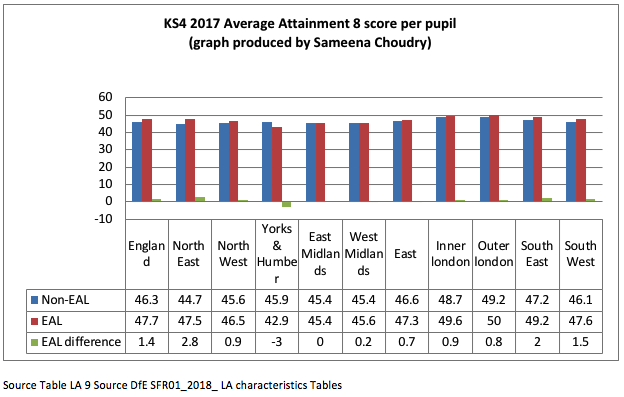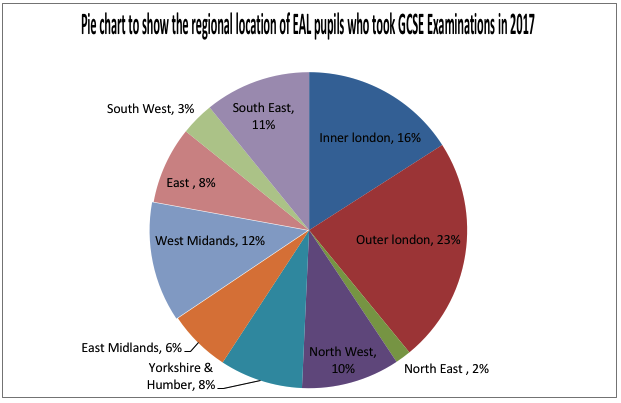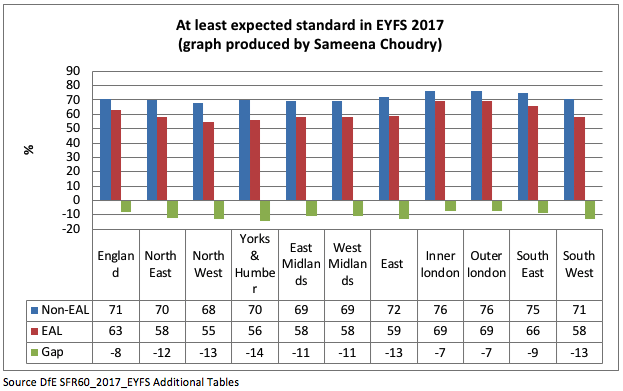The DfE recently published national data showing that, for the first time, average performance of EAL learners in GCSE examinations is higher than average performance of non-EAL pupils. This finding has prompted some to suggest that improving outcomes for EAL pupils has come at the expense of ‘white working class’ pupils. Sameena Choudry, founder of Equitable Education a consultancy that works with schools to help close achievement gaps for children and young people, takes a closer look at the data.

The attainment of pupils for whom English is an additional language (EAL) has hit the headlines again, with many lamenting that ‘white British’ children now do worse in their GCSEs than pupils whose first language is English. This reading of the findings feeds into anti-immigration rhetoric that argues that ‘white working class’ pupils are being left behind. A closer reading, however, reveals the fallacy of this argument.
There certainly have been significant year on year improvements in the attainment of EAL pupils, and this year’s GCSE results do show that EAL pupils have outperformed non-EAL pupils. This is definitely a cause for celebration. The hard work of pupils, their families and schools deserves full recognition, particularly at a time when the percentage of EAL pupils have grown so that they now form over a fifth of the pupil population.
It is worth noting that this year the DfE have also introduced new performance measures for GCSEs: Average Attainment 8 and Average Progress 8 score per pupil. In addition, the benchmark for good attainment at GCSE has been raised. Now pupils are judged by how many grades 9-5 they attain, the lower band of which is higher than previous years. In previous years they were judged by how many grades A*- C they attained (C being equivalent to grade 4 in the new system).
When looking at the DfE’s recently published data for regions and Local Authorities (LAs), we see that in every region apart from Yorkshire and Humber, EAL pupils either performed slightly better or the same as their non-EAL peers.

However, when the figures are adjusted to reflect the more generous benchmark of previous years a slightly different picture emerges. EAL pupils still performed more or less the same nationally as their non-EAL peers, with EAL pupils performing better in Inner London, the South East and North East. However, EAL pupils did not do as well in other regions, with nearly an eight percentage point gap in Yorkshire and Humber. Furthermore, when looking at this same measure EAL girls also performed slightly lower than non-EAL girls nationally (67.7% vs. 68%). It is, therefore, worth considering whether some of the improvements highlighted in the news headlines can be accounted for by changes in the performance measures.

What is certainly undeniable are the faster rates of progress of EAL pupils compared to their non-EAL peers. This phenomenon has been taking place for many years, particularly in Key Stage 4 (see Wilson 2005). By the time they reach KS4, EAL pupils have usually acquired the cognitive academic language proficiency (CALP) needed to be successful in examinations, a process that can take up to 5-7 years (Cummins 2008; Collier 1987) or even 6-8 years (Demie 2016) for some EAL pupils. Once EAL pupils have acquired CALP they often make accelerated rates of progress and catch up with their peers.
Most LAs in London and many of the surrounding regions see pupils from many backgrounds perform highly, including EAL pupils. Importantly though, EAL pupils are represented in much greater numbers here than in other parts of the country (39% of pupils in London rising to 50% if the South East is included). The higher average results for EAL pupils nationally, therefore, are heavily influenced by the disproportional numbers of EAL pupils in those areas that invest in expertise and resources to support their teaching of EAL learners. By way of illustration, London schools have benefitted from being well funded and being in receipt of extra funding due to higher percentages of EAL and disadvantaged children. This additional funding has also helped them provide specialist support for pupils with EAL, by recruiting experienced and well trained EAL teachers and EAL support staff. This factor is often not taken into consideration when commenting on the success of London Challenge, and neither is the fact that there was a specific strand of work on professional development for teachers on EAL here.

Much has been written about the London effect, with Burgess (2014) making a compelling case for attributing the significant improvements in attainment in London and other larger cities to their ethnic composition and their higher aspirations and ambition. Burgess also states that the newer EAL pupils settling in London are from highly qualified families. Greaves (2014) meanwhile, attributes much of London’s educational success to the significant improvements in primary schools as a result of different initiatives such as the national literacy strategy, which meant that secondary schools in London could build on these higher levels of attainment on entry.
It is also interesting that the attainment of EAL pupils is noticeably much lower in many LAs, including those with a higher percentage of EAL pupils such as Oldham, Rochdale, Salford in the North West; Bradford, Calderdale, Kirklees, Leeds, Rotherham, Sheffield in Yorkshire and Humber; Stoke on Trent, Walsall, Wolverhampton in the West Midlands; Luton, Peterborough and Suffolk in the East. Some of this is likely due to the different ethnic and socio-economic composition of their EAL pupil populations, but it highlights that the headlines mask considerable regional disparities.
There are other considerations which need to be taken on board when looking at the attainment of EAL pupils. The performance of EAL pupils is much lower at the start of statutory schooling nationally, with wide gaps between EAL and non-EAL pupils in many regions, as the following graph shows.

These gaps are exacerbated when disaggregated by gender. The lower starting points for EAL pupils then lead to better rates of progress as they move through their schooling. Gaps between EAL pupils and non-EAL pupils are still evident in Key Stage 2.

It is worth also noting that the gap between EAL and non-EAL pupils for reading is notably larger than the gaps for aggregated results shown in the graph.
In addition, the headline data for EAL pupils also considerably masks the differential attainment of EAL pupils associated with a variety of other important factors, which are not accounted for in the national data published by the DfE. Strand et al. (2015) demonstrated that the ethnicity of EAL pupils matters. Their research showed that EAL pupils classified as White Other, Black African and Pakistani perform lower than other groups. Gender and free school meal eligibility are also key factors, although the latter has a lesser impact on EAL and BME pupils than White British pupils. In addition, the age of arrival of pupils to the UK (where applicable) has important associations with attainment, with those having been here for at least five years before taking an examination doing better than those who are more recent arrivals. Other factors that must be considered include whether the EAL pupil has identified special educational needs, and levels of pupil mobility. Pupil mobility is considerably higher for EAL cohorts and impacts on educational outcomes.
Fluency in English is also related to attainment. Demie’s recent research into fluency in English shows that the newly introduced EAL proficiency stages can provide important information in determining the likely academic success of EAL pupils. Those assessed as at Stages D (Competent) and E (Fluent) not only performed much higher than those at the earlier stages of English language acquisition, but also considerably outperformed their monolingual peers.
Perhaps the most striking and significant factor to consider along with ethnicity and socio-economic factors, is the language background of the pupil. Demie and colleagues (2016) also undertook research which revealed how the languages spoken by pupils are associated with considerable variation in their attainment. For example, he looked into the association between GCSE results and the languages spoken by four main ethnic groups – White Other, Black African, Pakistani and Indian. Each ethnic group represented a wide range of languages and considerable variation in attainment. When looking at attainment by languages spoken, they found that the highest performing language groups overall were the Indian languages of Marathi and Telugu. These pupils performed over 30 percentage points higher than the national figure at the time. Closely following were Japanese, Sinhala, Malayalam, Danish, and Vietnamese speakers who all performed more than 20 percentage points higher than the national figure.
At the opposite end, the lowest attaining groups overall were Czech speakers who performed more than 47% lower than the national average and considerably lower than so called ‘white working class pupils’, who are often cited as the lowest performing group. They were closely followed by Romani Slovak and Romany/English Romanes speaking pupils, who were more than 30 percentage points lower than the national average. Other low attaining groups were Thai, Latvian, Lithuanian and Pashto speakers. The present definition of EAL fails to capture the huge diversity that I have illustrated above. The term captures only that a pupil is exposed to other languages in the homes. It does not attempt to gather information on pupil’s English language proficiency or whether they are third or fourth generation children of established British families, children who are often incorrectly labelled ’immigrants’. Their attainment is included under the broad category of EAL along with those who may have arrived more recently with little or no previous exposure or learning of English or in some cases of schooling altogether. All of these data show that the binary EAL and non-EAL divide is an unhelpful way to represent the attainment of different groups of pupils.
Considering the growing diversity of our pupil population, with over a third being of black and minority ethnic backgrounds and a fifth classified as EAL, the recent DfE move to introduce the EAL proficiency stages is a step in the right direction but this requires more training and support to be given to schools to ensure accurate assessments. The DfE also needs to go further and collect considerably more information, as I have highlighted, to accurately assess the attainment of pupils who speak additional languages so that support can be channelled to those who are currently under attaining or who are at risk of under attaining. These detailed attainment data then need to be published as part of a statistical first release, along with a breakdown by specific ethnic groups for individual regions, LAs and Multi Academy Trusts, rather than the in broad aggregate groups which render them almost meaningless.
Furthermore, an honest and important discussion needs to take place whereby the label of ‘white working class’ is not used interchangeably with pupils classified a White British who receive free school meals. There is a considerable difference between the approximate 13% or so of pupils classified as White British who receive free school meals compared with the 60% of the public who consider themselves to be working class (Evans & Melon, 2016). The term ‘white working class’ has become popular in anti-immigration rhetoric. It is frequently used to argue that all white working class people are being left behind, and regularly features in newspaper headlines as evidence that minority ethnic groups are taking what some perceive to be rightfully theirs.
The under attainment of pupils classified as White British who receive free school meals is without a doubt a considerable failing of our education system. It rightly deserves attention and resources. However, it is unacceptable to use this rhetoric to justify a focus on that group of pupils at the expense of other pupils who also require additional support. People who do this seem to forget that most minority ethnic groups have much higher rates of free school meal eligibility, with the exception of Indian and Chinese pupils. Indeed, many newer communities may not even be eligible to claim free school meals even though the Income Deprivation Affecting Children Index (IDACI) scores for where they live demonstrate that they are living in poverty. Others simply don’t take up the offer of free school meals. This has the effect of showing lower levels of school meal eligibility than in other circumstances would be the case (Strand 2016). As such their specific needs are often overlooked.
Finally, there is still much to do in ensuring that EAL and BME young people who do attain well at GCSE are able to gain access to the more prestigious universities, achieve higher degree outcomes than they are currently, and to make sure they are in paid employment commensurate to their qualifications so as not to be unequally subject to higher rates of unemployment. Sadly, too many are also still unequally subject to higher rates of unemployment despite their hard work and qualifications. Let’s celebrate the achievements but also be honest and open about what the headline data does not show and move to address the challenges that lay ahead so that there is equity in the education system for all.
You can follow Sameena on twitter @EquitableEd
References
Burgess S (2014). Understanding the success of London’s schools. CMPO, University of Bristol.
Collier V (1987). Age and Rate of Acquisition of Second Language for Academic Purposes. TESOL Quarterly, 21(4 ) 617-641.
Cummins J (2008). BICS and CALP: Empirical and Theoretical Status of the Distinction by Jim Cummins: The University of Toronto. In: Street B & Hornberger NH (Eds.) Encyclopedia of Language and Education, 2nd Edition, Volume 2: Literacy. (pp. 71-83). New York: Springer.
Demie F, Hau A, & Mcdonald J (2016). Language Diversity and Attainment in Secondary Schools in England. London: Lambeth Research and Statistics Unit.
Evans G & Mellon J (2016). British Social Attitudes Report 33: Social Class (June 2016). NatCen. Available at: http://www.bsa.natcen.ac.uk/latest-report/british-social-attitudes-33/introduction.aspx.
Greaves E, Macmillan L & Sibieta L (2014). Lessons from London schools for attainment gaps and social mobility. SMCP Research Report SMCP-RR363
Strand S, Malmberg L, Hall J (2015). English as an Additional Language (EAL) and educational achievement in England: An analysis of the National Pupil Database. University of Oxford, Bell Foundation, Unbound and EEF.
Wilson D, Burgess S, Briggs A, (2005). The Dynamics of School Attainment of England’s Ethnic Minorities. CMPO University of Bristol.

